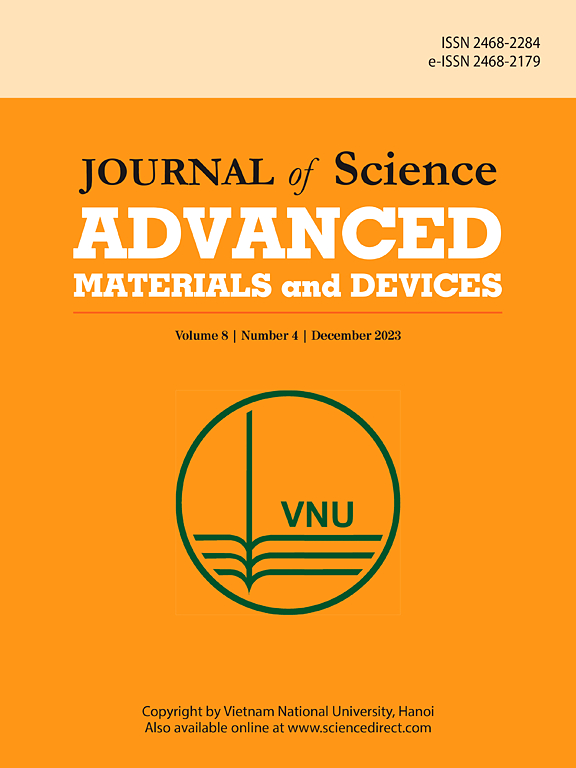再生能源:再利用甲基橙染料吸附的聚噻吩/Fe3O4纳米棒/还原氧化石墨烯纳米复合材料作为超级电容器电极
IF 6.7
3区 材料科学
Q1 MATERIALS SCIENCE, MULTIDISCIPLINARY
Journal of Science: Advanced Materials and Devices
Pub Date : 2025-02-11
DOI:10.1016/j.jsamd.2025.100865
引用次数: 0
摘要
本研究通过甲基橙(MO)染料吸附的聚噻吩/氧化铁/还原氧化石墨烯纳米复合材料(PTh/Fe3O4/RGO)在废水处理和储能方面的双重功能,提出了一种可持续的废物转化为财富的方法。初步采用PTh/Fe3O4/RGO纳米复合材料作为有效的吸附剂去除废水中的有害MO染料。吸附成功后,染料饱和PTh/Fe3O4/RGO被重新用作超级电容器电极,以研究其储能能力。MO吸附前的电化学测试表明,原始PTh/Fe3O4/RGO电极具有良好的性能,在1 Ag−1时的比电容为467.3 Fg−1,在5000次恒流充放电(GCD)循环中保持95.3%的良好循环稳定性。在pH为3、用量为2.5 gL−1、接触时间为120 min、MO浓度为50 mgL−1的条件下,PTh/Fe3O4/RGO对MO的吸附量达到最大。Langmuir等温线、拟二级动力学和Dubinin-Radushkevich (D-R)等温线很好地解释了吸附行为,表明吸附过程的单层容量为151.34 mg - 1。热力学分析表明,该反应焓为正(ΔH°),吉布斯自由能为负(ΔG°),证实了该反应为吸热自发反应。解吸实验表明,第一次循环可解吸88.72%的MO,使用NaOH可有效再生6次。吸附后,该材料仍然保持了显著的超级电容器性能,在1 Ag−1时的比电容为380.9 Fg−1,在5000 GCD循环中循环稳定性为83.2%。这项研究展示了一种循环的、可持续的方法,将废物处理与能量储存相结合,突出了材料在多功能应用中的再利用潜力。本文章由计算机程序翻译,如有差异,请以英文原文为准。

Recycling waste for energy: Reusing methyl orange dye-adsorbed polythiophene/Fe3O4 nanorods/reduced graphene oxide nanocomposite as a supercapacitor electrode
This study presents a sustainable waste-to-wealth approach by repurposing methyl orange (MO) dye-adsorbed polythiophene/iron oxide/reduced graphene oxide nanocomposite (PTh/Fe3O4/RGO) for dual functionality in wastewater treatment and energy storage. PTh/Fe3O4/RGO nanocomposite was initially employed as an effective adsorbent to remove harmful MO dye from wastewater. After successful adsorption, the dye-saturated PTh/Fe3O4/RGO was repurposed as a supercapacitor electrode to investigate its energy storage capabilities. Electrochemical tests before MO adsorption revealed that the pristine PTh/Fe3O4/RGO electrode demonstrated promising performance with a specific capacitance of 467.3 Fg−1 at 1 Ag−1 and excellent cyclic stability of 95.3% retention over 5000 Galvanostatic charge-discharge (GCD) cycles. Further, the maximum adsorption of MO by the PTh/Fe3O4/RGO was achieved under optimal conditions: pH 3, 2.5 gL−1 dosage, 120 min contact time, and 50 mgL−1 MO concentration. The adsorption behaviour was well-explained by the Langmuir isotherm, pseudo-second-order kinetics, and Dubinin-Radushkevich (D-R) isotherm, indicating a physical adsorption process with a monolayer capacity of 151.34 mgg−1. Thermodynamic analysis, with a positive enthalpy (ΔH°) and negative Gibbs free energy (ΔG°), confirmed that the process is endothermic and spontaneous. Desorption studies showed that 88.72% of the MO could be desorbed in the first cycle, with effective regeneration up to six cycles using NaOH. Post-adsorption, the material still retained significant supercapacitor properties, with a specific capacitance of 380.9 Fg−1 at 1 Ag−1 and 83.2% cyclic stability over 5000 GCD cycles. This study demonstrates a circular, sustainable approach that integrates waste treatment with energy storage, highlighting the potential of reusing materials for multifunctional applications.
求助全文
通过发布文献求助,成功后即可免费获取论文全文。
去求助
来源期刊

Journal of Science: Advanced Materials and Devices
Materials Science-Electronic, Optical and Magnetic Materials
CiteScore
11.90
自引率
2.50%
发文量
88
审稿时长
47 days
期刊介绍:
In 1985, the Journal of Science was founded as a platform for publishing national and international research papers across various disciplines, including natural sciences, technology, social sciences, and humanities. Over the years, the journal has experienced remarkable growth in terms of quality, size, and scope. Today, it encompasses a diverse range of publications dedicated to academic research.
Considering the rapid expansion of materials science, we are pleased to introduce the Journal of Science: Advanced Materials and Devices. This new addition to our journal series offers researchers an exciting opportunity to publish their work on all aspects of materials science and technology within the esteemed Journal of Science.
With this development, we aim to revolutionize the way research in materials science is expressed and organized, further strengthening our commitment to promoting outstanding research across various scientific and technological fields.
 求助内容:
求助内容: 应助结果提醒方式:
应助结果提醒方式:


